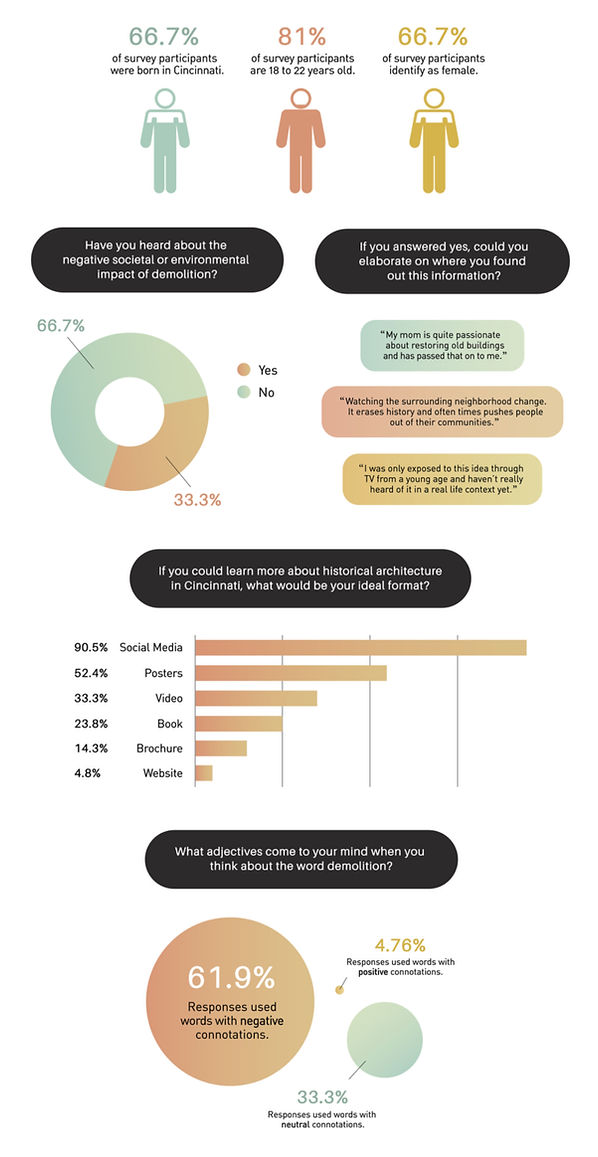THE REAL WRECKAGE
Summer 2022-Spring 2023

THE CONCEPT
The Real Wreckage is an illustrated book that teaches young adults about the value of old architecture. It tells the story of three structures in Cincinnati that have been demolished, and it highlights the artistic and historical merit of each building with engaging illustrations and simple typography.
For my senior capstone, I designed this book to encourage readers to take interest in the subject of architectural preservation, with the hope of ultimately increasing the survival rate of the buildings we value.

PRELIMINARY RESEARCH
Cincinnati, Ohio is home to one of the most impressive collections of historic architecture in the country. From Art Deco to Italianate, these buildings represent the city's cultural heritage and tell the stories of our past.
This subject inspired my capstone senior year. I spend a semester researching historical preservation and notable buildings in Cincinnati and determining the
best graphic design format to incorporate these concepts.

OLD MAIN LIBRARY
Demolished in 1955
James W. McLaughlin designed a grand opera house turned library, which served Cincinnati residents for 85 years. Updates in technology rendered the building useless, and it was replaced by a parking garage.

ALBEE THEATER
Demolished in 1977
The prime destination to see vaudeville and movies downtown. Guests were in awe of its Neoclassical, marble-arched façade and Rococo interior design. The rise of television and suburban living led to its demise.

THE GAMBLE HOUSE
Demolished in 2013
Procter & Gamble descendant James Gamble once lived in a beautiful Victorian mansion in Westwood. Despite community efforts to save it, many issues with ownership after James' passing led to it's eventual demolition.
USER SURVEY
Young adults in Cincinnati make up my target audience. I felt that this age group was the most open to learning about the topic of historical preservation, and my project could encourage kids to advocate for sustaining old architecture for the future.

BOOK CONTENT
In my initial phase of research, I found news articles, photos, and documentaries, and interviewed my professors that were well-versed on the demolition of historical buildings in Cincinnati. I decided to use content from Lost Cincinnati by Jeff Suess for the foundation of my book.

Photo: Hailey Bollinger
CONTEXT VISUALIZATION
I organized my target audience's wants and needs and completed different methods of context visualization to organize my insights, including an affinity diagram, stakeholder map, persona groups, and experience map.
PERSONAS


AFFINITY DIAGRAM
BOOK DESIGN
MOODBOARD
After a semester of ideation, I started to benchmark and find imagery that represented the visual style I was envisioning, which included bright earth tones, structured illustrations with detailed line work and large blocks of color, and spreads that contrasted small copy with large headlines.

VISUAL LANGUAGE

IMAGERY
I chose illustration as a vehicle to tell the story of my hometown. Using Procreate and Photoshop I gave the old buildings new life, and I had fun experimenting with color and interesting shapes to compliment the copy on each spread.
The time-lapse below showcases my process, from initial sketches to a finished piece.

THE REAL WRECKAGE






